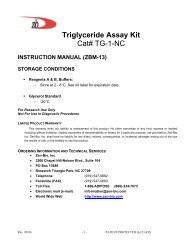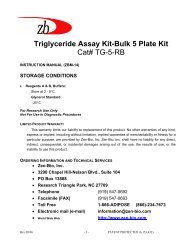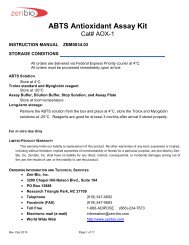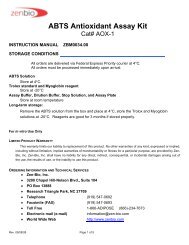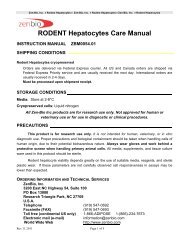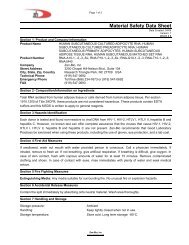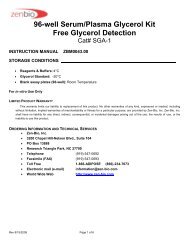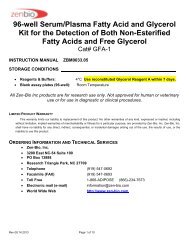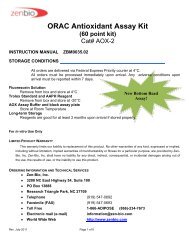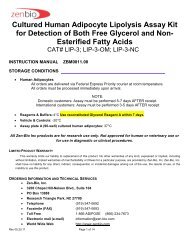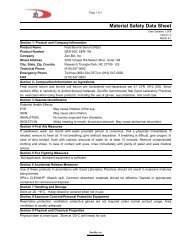Human Adiponectin ELISA Kit User Manual (ADIP-1 - Zen-Bio Inc.
Human Adiponectin ELISA Kit User Manual (ADIP-1 - Zen-Bio Inc.
Human Adiponectin ELISA Kit User Manual (ADIP-1 - Zen-Bio Inc.
You also want an ePaper? Increase the reach of your titles
YUMPU automatically turns print PDFs into web optimized ePapers that Google loves.
<strong>Zen</strong>-<strong>Bio</strong>, <strong>Inc</strong>.B-Bridge International, <strong>Inc</strong>.<strong>Human</strong> <strong>Adiponectin</strong> <strong>ELISA</strong> <strong>Kit</strong><strong>User</strong> <strong>Manual</strong> ZBM0006.00UM-100101Published 01 October 2002Catalog# <strong>ADIP</strong>-1 and <strong>ADIP</strong>-2
<strong>Human</strong> <strong>Adiponectin</strong> <strong>ELISA</strong> <strong>Kit</strong> <strong>User</strong> <strong>Manual</strong>Rev. 12/04See List of Components for Storage ConditionsFOR RESEARCH USE ONLYMouse Anti-<strong>Human</strong> <strong>Adiponectin</strong>Monoclonal Ab Coated PlateSample Pre-TreatmentTable of ContentsWash (350 L x 1)Standards and Pre-Treated Samples 100 LI. Introduction and Protocol Overview 3II. List of Components 5III. Additional Materials Required 1st Reaction:20-30C, 60min6IV. Reagent Preparation and Storage 7V. Adipocyte Treatment Wash (350 L x 3)8VI. Sample Pre-Treatment 9VII. <strong>Human</strong> <strong>Adiponectin</strong>Secondary Rabbit<strong>ELISA</strong>Anti-<strong>Adiponectin</strong>ProtocolAb 100 L10VIII. Calculation of Results 12IX. Troubleshooting Guide and FAQs 13X. References 2nd Reaction:20-30C, 60min19Prepare DetectionAb SolutionWash (350 L x 3)Detection Ab Solution100 LPrepareSubstrate SolutionWash (350 L x 3)3rd Reaction:20-30C, 60minSubstrate Solution100 LNotice to PurchaserThis product is for research use only. It is not intended for human, veterinary, or in vitrodiagnostic use. Proper precautions Stop Solution and biological containment 100 L should be taken when handlingcells of human origin, due to their potential biohazardous nature. Always wear gloves and workbehind a protective screen when handling primary human cells. All media, supplements, andtissue culture ware used in this protocol should be sterile. <strong>Zen</strong>-<strong>Bio</strong> and B-Bridge products maynot be resold, modifiedReadfor resale,Absorbanceor usedat 450nmto manufacture commercial products without theexpress written consent of <strong>Zen</strong>-<strong>Bio</strong>, <strong>Inc</strong> and B-Bridge International, <strong>Inc</strong>.2002, B-Bridge International, <strong>Inc</strong>. All Rights Reserved.2002, <strong>Zen</strong>-<strong>Bio</strong>, <strong>Inc</strong>. All Rights Reserved.Color Development:20-30C, 15minB-Bridge International, <strong>Inc</strong>.<strong>Zen</strong>-<strong>Bio</strong>, <strong>Inc</strong>2www.b-bridge.comwww.zen-bio.com
<strong>Human</strong> <strong>Adiponectin</strong> <strong>ELISA</strong> <strong>Kit</strong> <strong>User</strong> <strong>Manual</strong>I. Introduction and Protocol OverviewObesity, and obesity-related disorders, are reaching alarming proportions in the US, and are on theincrease in Europe and Asia. A deeper understanding of the molecular and cellular dynamics of suchdisorders, and their subsequent amelioration, will have a far-reaching impact on the quality of life ofmillions of people worldwide.Adipocytes (fat cells) express a variety of proteins that function in the homeostatic control of glucoseand lipid metabolism. Insulin regulates the translocation and secretion of many of these proteins inresponse to changes in energy balance. Adipocyte complement-related protein of 30 kDa (Acrp30),now known as adiponectin, is a protein whose secretion from adipocytes is enhanced by insulinstimulation.It has been suggested that the development of non-insulin dependent (Type II) diabetes may involvedysregulation of adiponectin secretion (1). In support of the link between obesity and Type II diabetes,it has been shown that decreased expression of adiponectin correlates with insulin resistance (2,3),and that adiponectin appears to be a potent insulin enhancer linking adipose tissue and whole-bodyglucose metabolism (4).This <strong>Human</strong> <strong>Adiponectin</strong> <strong>ELISA</strong> <strong>Kit</strong> is designed to measure the concentration of human adiponectinfrom human serum/plasma, human adipocytes, or conditioned medium.The principle of the assay is shown in Figure 1. Pre-treated samples and serially diluted standard(recombinant human adiponectin) solutions are added to an appropriate number of wells of themicrotiter plate and incubated. <strong>Adiponectin</strong> in the sample will be bound by the primary anti-adiponectinmonoclonal antibody immobilized in the well (1 st Reaction). After washing, the secondary rabbitanti-adiponectin antibody is added to each well and allowed to incubate (2 nd Reaction). The secondaryrabbit anti-adiponectin polyclonal antibody will bind to the adiponectin trapped in the well in the 1 stReaction. After washing, a conjugate of horseradish peroxidase and goat anti-rabbit IgG is added toeach well and allowed to incubate (3 rd Reaction). The detection antibody will recognize and bind to therabbit anti-adiponectin antibody trapped in the well in the 2 nd Reaction. After washing, the colorimetricsubstrate for the enzyme is added to all wells and incubated. The color development is terminated bythe addition of a stop solution. The intensity of the color is measured at 450 nm. The concentrations ofthe samples tested are calculated using the absorbance values of the adiponectin standard solutionsassayed at the same time.B-Bridge International, <strong>Inc</strong>.<strong>Zen</strong>-<strong>Bio</strong>, <strong>Inc</strong>3www.b-bridge.comwww.zen-bio.com
<strong>Human</strong> <strong>Adiponectin</strong> <strong>ELISA</strong> <strong>Kit</strong> <strong>User</strong> <strong>Manual</strong>II.List of Components Store components 1-13 at 2-8C. DO NOT FREEZE. Store component 14 in a humidified CO 2 incubator at 37C, 5% CO 2.1 25X WASH SOLUTION 1 Bottle (40mL)2 SAMPLE PRE-TREATMENT SOLUTION 1 Bottle (10mL)3 5X SAMPLE DILUENT 1 Bottle (50mL).4 PRIMARY ANTIBODY-COATED PLATE 1 PlateOne plate holds 12x8-well strips (96 wells), with adsorbedmouse anti-human adiponectin monoclonal antibody. Plateis provided in a resealable foil pouch with desiccant.5 <strong>ADIP</strong>ONECTIN STANDARD 1 Vial (2mL)Recombinant human adiponectin (12.0 ng/mL)6 SECONDARY ANTIBODY SOLUTION 1 Bottle (12mL)Rabbit anti-human adiponectin polyclonal antibody7 DETECTION ANTIBODY CONCENTRATE 1 Vial (0.1mL)Horseradish peroxidase (HRP)-conjugated goat anti-rabbit IgG8 DETECTION ANTIBODY DILUENT 1 Bottle (15mL)9 SUBSTRATE A 1 Bottle (7.5mL)10 SUBSTRATE B 1 Bottle (7.5mL)11 STOP SOLUTION 1 Bottle (15mL)Components 12-15 for <strong>ADIP</strong>-2 kit only12 ZEN-BIO PPAR AGONIST 1 vial (500μl)13 BASAL MEDIUM (BM-1) 1 Bottle (30mL)14 <strong>ADIP</strong>OCYTE MEDIUM (AM-1) 1 Bottle (50ml)15 HUMAN SUBCUTANEOUS <strong>ADIP</strong>OCYTES 96 well platePLATE SEALERSSix sealers per package1 PackageMSDS forms are available on our website—please visit www.b-bridge.comB-Bridge International, <strong>Inc</strong>.<strong>Zen</strong>-<strong>Bio</strong>, <strong>Inc</strong>5www.b-bridge.comwww.zen-bio.com
<strong>Human</strong> <strong>Adiponectin</strong> <strong>ELISA</strong> <strong>Kit</strong> <strong>User</strong> <strong>Manual</strong>III.Additional Materials RequiredThe following materials are required, but not supplied:Graduated cylinderMicropipettor(s) and disposable pipette tipsNull strips for 96-well plate96-well plate or manual strip washerPaper towels or absorbent paperPlate reader capable of measuring absorbance at a wavelength of 450nm (reference filter at650 nm, optional)Heat block or equivalentWell-closed containers such as microtubes (1.5 mL or more in capacity) or 96 well plate thatfits into a 96 well plate heat block and can withstand temperatures up to 100ºC.B-Bridge International, <strong>Inc</strong>.<strong>Zen</strong>-<strong>Bio</strong>, <strong>Inc</strong>6www.b-bridge.comwww.zen-bio.com
<strong>Human</strong> <strong>Adiponectin</strong> <strong>ELISA</strong> <strong>Kit</strong> <strong>User</strong> <strong>Manual</strong>IV. Reagent Preparation and Storage1. 1X Wash SolutionPrepare 1X Wash Solution by mixing all of the 25X Wash Solution (40mL) with 960 mL ofdeionized water or equivalent. If crystals are observed in the 25X Wash Solution bottle, warm thebottle in a 37°C water bath until the crystals disappear. After preparation, store 1X Wash Solutionat 2-8°C.2. 1X Sample DiluentPrepare 1X Sample Diluent by mixing all of the 5X Sample Diluent (50mL) with 200mL ofdeionized water or equivalent. After preparation, store 1X Sample Diluent at 2-8°C.3. <strong>Adiponectin</strong> Standard SolutionPrepare each <strong>Adiponectin</strong> Standard (6.0 ng/mL, 3.0 ng/mL, 1.5 ng/mL, 0.75 ng/mL,0.375 ng/mL)by serially diluting the supplied adiponectin standard solution (12.0 ng/mL) with 1X SampleDiluent . Use undiluted adiponectin (12.0 ng/mL) and 1X Sample Diluent for 12.0 ng/mL and 0ng/mL standard solutions, respectively.4. Detection Antibody SolutionPrepare the Detection Antibody Solution by adding one part Detection Antibody Concentrate to200 parts Detection Antibody Diluent. Prepare only as much Detection Antibody Solution asneeded.5. Substrate SolutionPrepare the Substrate Solution by adding one part Substrate A to one part Substrate B. Prepareonly as much Substrate Solution as needed. Return Substrate A to 2-8°C immediately afterthe necessary volume is removed.Next step is for treating samples from human cultured adipocytes only (kit catalog # <strong>ADIP</strong>-2)6. Sample Pre-Treatment SolutionDilute sample pre-treatment solution as follows. Remove 2 ml sample pre-treatment solution toclean conical tube. Add 8 ml diH 2 0. Invert to mix. Prepare samples for pre-treatment in thissolution.Note: Do not mix reagents from different kits unless they have the same lot number.B-Bridge International, <strong>Inc</strong>.<strong>Zen</strong>-<strong>Bio</strong>, <strong>Inc</strong>7www.b-bridge.comwww.zen-bio.com
<strong>Human</strong> <strong>Adiponectin</strong> <strong>ELISA</strong> <strong>Kit</strong> <strong>User</strong> <strong>Manual</strong>V. Adipocyte Treatments (applies only to <strong>ADIP</strong>-2 kit)This kit contains one 96 well plate of cultured human subcutaneous adipocytes. Werecommend using no more than 84 wells for all treatments and controls in order to leave room onthe <strong>ELISA</strong> plate for the standard curve (duplicate wells). We recommend the following procedurefor treatment of the adipocytes:On the day the cells arrive:1. Check the seal for each plate. Please be aware that these cells are of human origin. Pleasetreat them as potentially infectious since we cannot test for all pathogens. ALWAYS WEARGLOVES AND USE PROTECTIVE MEASURES WHEN HANDLING HUMAN PRIMARYCELLS.2. Place the package into a sterile environment. THIS IS VERY IMPORTANT SINCEBREAKING THE VACUUM SEAL MAY POTENTIALLY INTRODUCE CONTAMINATION INTOTHE PLATE. Use scissors to snip open the bag at any end. The vacuum seal should bereleased at this time. You may notice some bubbling of the media in the plate at this time.This is normal and will not affect cell performance.3. In a sterile environment, remove the plate from the bag, taking care to not disturb the cover topfrom the plate. Open the lid and remove the white liner using sterile forceps or a hemostatand discard. Carefully remove the clear adhesive seal by grabbing the edge with sterileforceps or hemostat and lifting the film slowly towards the other end. Discard adhesive film inappropriate biohazard waste container. Replace lid on plate.4. Warm the BM-1 included with the cells to 37ºC in a water bath.5. When the medium is warm remove 250 µl of the medium from all wells of the plate and replacewith 150 µl BM-1.6. Remove 150 µl of the medium and replace with a fresh 150 µl aliquot of BM-1. This processremoves all serum and hormone from the cells.7. Place cells in a 37ºC humidified incubator at 5% CO 2 . Allow cells to rest for 3 days.On the day of the assay:1. Prepare all treatments in AM-1. 500 µL PPAR agonist in AM-1 has been provided withthis kit and is ready for use.2. Remove medium from treatment wells and replace with appropriate treatment medium.3. <strong>Zen</strong>-<strong>Bio</strong> recommends treating in triplicate wells.4. No more than 89 of the wells can be used for treatment to allow room on the <strong>ELISA</strong> platefor the standard curve.5. After plate is treated place cells in a 37ºC humidified incubator at 5% CO 2. Suggestedtreatment time is 72 hours.6. At the end of the treatment period prepare the samples as described in section VI.B-Bridge International, <strong>Inc</strong>.<strong>Zen</strong>-<strong>Bio</strong>, <strong>Inc</strong>8www.b-bridge.comwww.zen-bio.com
<strong>Human</strong> <strong>Adiponectin</strong> <strong>ELISA</strong> <strong>Kit</strong> <strong>User</strong> <strong>Manual</strong>VI. Sample Pre-Treatment<strong>Human</strong> Serum or Plasma Samples1. Allow all the reagents needed for sample pre-treatment, including serum or plasma (EDTA- orheparin-containing), to come to room temperature (20-30°C) prior to the start of the samplepre-treatment.2. Mix 10 L of serum or plasma samples with 90 L of Sample Pre-treatment Solution and heat themixture for 5 minutes at 100°C using a heat block. To heat the samples, use well-closedcontainers (1.5 mL or more in capacity) such as microtubes. NOTE: Make sure to eliminate theprecipitate in the Sample Pre-treatment Solution by warming to 37ºC.3. Add 900 L of 1X Sample Diluent to each container after heating (1:100 diluted samples at finalvolume).4. Transfer 20 L of each diluted sample to a clean container and then add 1.0 mL of 1X SampleDiluent to the container (1:5100 dilution at final volume). Repeat for each sample.<strong>Human</strong> Adipocyte Cellular Extracts or Conditioned Media From <strong>Human</strong> Adipocytes (<strong>ADIP</strong>-2 kit)1. Allow all the reagents needed for sample pre-treatment, including cellular extracts or conditionedmedia, to come to room temperature (20-30°C) prior to the start of the sample pre-treatment.2. Mix 20 L of the adipocyte cellular extract or conditioned media with 80 L of Diluted SamplePre-treatment Solution (see step 6 in Reagent Preparation and Storage on page 7), and heat themixture for 5 minutes at 100°C using a heat block. To heat the samples, use well-closed containers(1.5 mL or more in capacity) such as microtubes. Alternatively, samples can be prepared in a 96well plate suitable for PCR work and heated in a PCR machine or other multi-well plate warmers.3. Add 400 L of 1X Sample Diluent to each container after heating (1:25 diluted samples at finalvolume). Alternatively, transfer 50 L of pretreated solution from step 2 to a new 96 well plateand add 200 L 1X Sample Diluent to each well. Pipet up and down gently to mix.B-Bridge International, <strong>Inc</strong>.<strong>Zen</strong>-<strong>Bio</strong>, <strong>Inc</strong>9www.b-bridge.comwww.zen-bio.com
VII <strong>Human</strong> <strong>Adiponectin</strong> <strong>ELISA</strong> Protocol<strong>Human</strong> <strong>Adiponectin</strong> <strong>ELISA</strong> <strong>Kit</strong> <strong>User</strong> <strong>Manual</strong>1. Allow all reagents to come to room temperature (20-30°C) prior to the start of the assay.Prepare 1X Wash Solution, 1X Sample Diluent, and <strong>Adiponectin</strong> Standards according to ReagentPreparation (Steps 1, 2, and 3).2. Remove Primary Antibody-Coated Plate from its foil pouch. Remove any unneeded strips from theplate frame, reseal them in the foil pouch, and return the foil pouch to 2-8°C. If a 96-well platewasher is used, the plate frame should be completely filled with wells by adding as many nullstrips as necessary. Identify well position(s) for each sample on a data sheet or plate map.3. Fill the wells with 1X Wash Solution (~350 L) and immediately aspirate using a plate washer. Ifwells are washed manually, invert the plate(s) and gently tap on a clean absorbent towel.4. Add 100 L of adiponectin standard or pre-treated sample to the appropriate number ofantibody-coated wells. Every plate must include the standard series to properly correlate thesample readings.5. Cover plate(s) securely with a plate sealer and incubate at 20-30°C for 60 minutes.6. Wash the plate(s) as follows:a. At the end of the incubation, carefully remove the plate sealer, avoiding splashing, anddiscard appropriately.b. Completely aspirate the liquid from the wells using a plate washer.c. Fill each well with 1X Wash Solution (~350 L/well) and immediately aspirate. Avoid WashSolution overflow.d. Repeat Step 6c two more times for a total of three washes.e. Invert the plate(s) and gently tap on a clean absorbent towel.7. Dispense 100 L of the Secondary Antibody Solution into each well.8. Cover plate(s) securely with a (new, clean) plate sealer and incubate at 20-30°C for 60 minutes.9. Repeat the wash procedure described in step 6.Prepare Detection Antibody Solution according to Reagent Preparation (Step 4).10. Dispense 100 L of Detection Antibody Solution into each well.11. Cover plate(s) securely with a plate sealer and incubate at 20-30°C for 60 minutes.Prepare Substrate Solution according to Reagent Preparation (Step 5).12. Repeat the wash procedure described in step 6.13. Dispense 100 L of Substrate Solution into each well.14. <strong>Inc</strong>ubate the plates at 20-30°C for 15 minutes.B-Bridge International, <strong>Inc</strong>.<strong>Zen</strong>-<strong>Bio</strong>, <strong>Inc</strong>10www.b-bridge.comwww.zen-bio.com
VII <strong>Human</strong> <strong>Adiponectin</strong> <strong>ELISA</strong> Protocol continued15. Dispense 100 L of Stop Solution into each well.<strong>Human</strong> <strong>Adiponectin</strong> <strong>ELISA</strong> <strong>Kit</strong> <strong>User</strong> <strong>Manual</strong>16. Read the plate at 450 nm using a plate reader. If using a dual filter instrument, the recommendedreference wavelength is 650nm.Figure 2. Flow Chart of Assay ProcedureMouse Anti-<strong>Human</strong> <strong>Adiponectin</strong>Monoclonal Ab Coated PlateSample Pre-TreatmentWash (350 L x 1)Standards and Pre-Treated Samples100 LWash (350 L x 3)1st Reaction:20-30C, 60minSecondary Rabbit Anti-<strong>Adiponectin</strong> Ab100 LPrepare DetectionAb SolutionWash (350 L x 3)2nd Reaction:20-30C, 60minDetection Ab Solution100 LPrepareSubstrate SolutionWash (350 L x 3)3rd Reaction:20-30C, 60minSubstrate Solution100 LColor Development:20-30C, 15minStop Solution100 LRead Absorbance at 450nmReference at 650nmB-Bridge International, <strong>Inc</strong>.<strong>Zen</strong>-<strong>Bio</strong>, <strong>Inc</strong>11www.b-bridge.comwww.zen-bio.com
Net-AbsorbanceVIII Calculation of Results<strong>Human</strong> <strong>Adiponectin</strong> <strong>ELISA</strong> <strong>Kit</strong> <strong>User</strong> <strong>Manual</strong>1. Subtract the mean absorbance value of the 0 ng/mL blank from each mean absorbance value ofthe standard series and samples tested (Net Absorbance).2. Plot the concentrations of each standard and the calculated Net Absorbances on the X-axis andY-axis, respectively. Fit an appropriate regression curve on the plots.3. Determine the adiponectin concentrations of the samples by interpolation of the regression curveformula.4. The adiponectin concentrations calculated must be multiplied by the appropriate dilution factor(x5100 for serum or plasma samples and x25 for adipocyte cellular extracts or conditionedmedium) to obtain the correct result for undiluted samples.Figure 3. Typical Standard Curve510.10.1 1 10 20Concentration of <strong>Adiponectin</strong>B-Bridge International, <strong>Inc</strong>.<strong>Zen</strong>-<strong>Bio</strong>, <strong>Inc</strong>12www.b-bridge.comwww.zen-bio.com
IX. Troubleshooting Guide and FAQs<strong>Human</strong> <strong>Adiponectin</strong> <strong>ELISA</strong> <strong>Kit</strong> <strong>User</strong> <strong>Manual</strong>Troubleshooting Guide1. Lack of signal or weak signal in all wellsPossible explanations:Omission of a reagent or a step.Improper preparation or storage of a reagent.Assay performed before reagents were allowed to come to 20-30C.Plate reader did not perform well.2. High signal and background in all wellsPossible explanations:Improper or inadequate washing; be certain that all wash volumes and repetitions werecorrect.Improper dilution of detection antibody.Overdeveloping; decrease the incubation time before the Stop Solution is added.3. High background in sample wells onlyPossible explanations:Sample concentration was too high.Improper dilution of detection antibody.4. Weak signal in sample wells onlyPossible explanations:Sample concentration was too low.Improper dilution of detection antibody.FAQs (Frequently Asked Questions)1. What is the shelf life of this kit?<strong>ADIP</strong>-1Currently, all components of this kit have a shelf life of 9 months when stored at 2-8C.However, it is fully anticipated that this will be extended in the future. The expiration dateappears on the top label of the product package.<strong>ADIP</strong>-2Must be used within 1 week of arrival.2. Can I pool reagents?Yes, as long as the reagents are from the same lot.3. What is the effect of freezing/thawing the standard and samples?No significant effect was observed when adiponectin standards, untreated samples,pre-treated samples and diluted samples were frozen and thawed five times (Figure 4).B-Bridge International, <strong>Inc</strong>.<strong>Zen</strong>-<strong>Bio</strong>, <strong>Inc</strong>13www.b-bridge.comwww.zen-bio.com
<strong>Human</strong> <strong>Adiponectin</strong> <strong>ELISA</strong> <strong>Kit</strong> <strong>User</strong> <strong>Manual</strong>IX Troubleshooting Guide and FAQs continuedFigure 4. Effects of Freeze/ThawOD 450nm-650nmUntreated <strong>Adiponectin</strong> (ng/mL)Std (ng/mL) NF F/T x3 F/T x5 NF F/T x3 F/T x512.000 2.235 2.220 2.181 No.31 1.308 1.171 1.2346.000 1.495 1.429 1.385 No.34 0.606 0.619 0.5663.000 0.902 0.848 0.839 No.35 3.453 3.561 3.4391.500 0.487 0.472 0.4600.750 0.266 0.262 0.253 Diluted <strong>Adiponectin</strong> (ng/mL)0.375 0.153 0.154 0.148 x5100 NF F/T x3 F/T x50.000 0.025 0.025 0.025 No.31 1.308 1.326 1.346No.34 0.606 0.691 0.708No.35 3.453 3.703 3.664NF = Not FrozenF/T = Freeze/ThawDiluted <strong>Adiponectin</strong> (ng/mL)x100 NF F/T x3 F/T x5No.31 0.882 0.889 0.866No.34 0.508 0.505 0.5194. Does the method of separation of serum/plasma affect the measurement ofadiponectin?There is no significant difference in measurements of adiponectin from separatedserum samples. However, neither whole blood nor whole blood treated with citratecan be used.Samples from three healthy individuals were taken and serum/plasma were treated byseveral different methods, results shown below (Figure 5).Figure 5. Effects of Separation MethodSerumPlasmaCoagulatedCoagulated+ Sep'n Gel Heparin Citrate EDTA (Na)23.234 3.422 3.136 2.766 3.3041.941 2.157 2.036 1.539 1.7441.275 1.289 1.206 0.990 1.127(<strong>Adiponectin</strong>:ng/mL)B-Bridge International, <strong>Inc</strong>.<strong>Zen</strong>-<strong>Bio</strong>, <strong>Inc</strong>14www.b-bridge.comwww.zen-bio.com
<strong>Adiponectin</strong> (ng/mL)<strong>Adiponectin</strong> (ng/mL)<strong>Adiponectin</strong> (ng/mL)<strong>Adiponectin</strong> (ng/mL)IX. Troubleshooting Guide and FAQs continued<strong>Human</strong> <strong>Adiponectin</strong> <strong>ELISA</strong> <strong>Kit</strong> <strong>User</strong> <strong>Manual</strong>5. At what temperature should samples be stored (both untreated and pre-treated)?Samples should be stored at -70C.6. How stable are the samples at 4C and at room temperature (RT)?Untreated serum and pre-treated x5100 diluted serum can be stored at 4C for up to 7 days.Pre-treated x100 diluted serum, however, cannot be stored refrigerated without a significantdecrease in detectable adiponectin (Figure 6).Figure 6. Measurement of <strong>Adiponectin</strong> After Storage at 4C1.201.000.800.600.400.200.00No.341 2 3 4 5Days at 4CSerum×100×51007.006.005.004.003.002.001.000.00No.351 2 3 4 5Days at 4CSerum×100×5100Untreated serum and pre-treated serum samples are stable for 8 hours at RT. Pre-treated x100diluted serum samples cannot be stored at RT without a decrease in detectable <strong>Adiponectin</strong> (Figure 7).Therefore, samples should be diluted x5100 following pre-treatment and heating. Ideally, all samplesshould be stored at -70C.Figure 7. Measurement of <strong>Adiponectin</strong> After Storage at RTNo.34No.351.006.000.800.600.400.200.000 1 2 3 4 5 6 7 8 9Hours at RTSerum×100×51005.004.003.002.001.000.000 1 2 3 4 5 6 7 8 9Hours at RTSerum×100×5100B-Bridge International, <strong>Inc</strong>.<strong>Zen</strong>-<strong>Bio</strong>, <strong>Inc</strong>15www.b-bridge.comwww.zen-bio.com
IX. Troubleshooting Guide and FAQs continued<strong>Human</strong> <strong>Adiponectin</strong> <strong>ELISA</strong> <strong>Kit</strong> <strong>User</strong> <strong>Manual</strong>7. What if I only heat the samples for 5 minutes in the pre-treatment incubation step?As shown in Figure 8 below, samples were heated at 100C in a heat block for 0 to 20minutes, then the <strong>ELISA</strong> was performed and the samples were tested. For samples heatedbetween 1 minute and 20 minutes, there was no significant difference in the adiponectinconcentrations recorded.Figure 8. Effects of Pre-Treatment <strong>Inc</strong>ubation TimesPre-Treatment <strong>Inc</strong>ubation Time (minutes)Sample 0 1 3 5 7 10 20No. 34 0.083 0.985 0.918 0.901 0.931 0.899 0.976No. 35 0.270 5.192 5.443 5.104 5.202 4.405 4.744(<strong>Adiponectin</strong>: ng/mL)8. What temperature range can I use in the pre-treatment incubation step?When samples were heated for 5 minutes at 5C intervals from 80C to 100C, there was nosignificant difference in the adiponectin concentrations recorded (Figure 9).Figure 9. Effects of Pre-Treatment <strong>Inc</strong>ubation TemperaturePre-Treatment <strong>Inc</strong>ubation Temp (°C)Sample 80 85 90 95 100No.34 1.057 1.047 1.044 1.122 1.040No.35 5.830 5.655 5.870 6.145 5.814(<strong>Adiponectin</strong>: ng/mL)9. How reproducible are the results?Several experiments were performed to determine the reproducibility of data obtained usingthis kit. In one experiment, 8 control high and control low samples were assayed (i.e., 16samples total on one plate, measured on a plate reader simultaneously), data shown inFigure 10 (first table). In the second table are the results of measuring single control high andlow samples from the same <strong>ELISA</strong> 6 times consecutively (i.e., one sample of each measuredon a plate reader 6 times in a row). The third table shows the results of eight assays (controlhigh and low) run by four different people.B-Bridge International, <strong>Inc</strong>.<strong>Zen</strong>-<strong>Bio</strong>, <strong>Inc</strong>16www.b-bridge.comwww.zen-bio.com
<strong>Adiponectin</strong> (ng/mL)IX. Troubleshooting Guide and FAQs continued<strong>Human</strong> <strong>Adiponectin</strong> <strong>ELISA</strong> <strong>Kit</strong> <strong>User</strong> <strong>Manual</strong>Figure 10. Reproducibility8 Samples From Same Plate Measured Simultaneouslytest-1 test-2 test-3 test-4 test-5 test-6 test-7 test-8 mean SDControl High 2.648 2.722 2.746 2.715 2.51 2.831 2.759 2.783 2.714 0.098Control Low 0.717 0.714 0.706 0.752 0.706 0.739 0.684 0.687 0.713 0.0232 Samples Measured 6 Times Consecutivelytest-1 test-2 test-3 test-4 test-5 test-6 mean SD CV (%)Control High 2.714 2.803 2.934 3.203 3.001 2.921 2.929 0.169 5.8Control Low 0.713 0.699 0.776 0.737 0.786 0.731 0.740 0.034 4.68 Assays by 4 Different Peopletest-1 test-2 test-3 test-4 mean SD CV (%)Control High 2.829 3.016 2.872 3.001 2.930 0.0931 3.2Control Low 0.780 0.698 0.835 0.786 0.775 0.0568 7.3(<strong>Adiponectin</strong>: ng/mL)10. What is the range of adiponectin that can be detected by this kit?We have established a minimum detectable limit as 23.4 pg/mL of adiponectin (unpublisheddata). The <strong>ELISA</strong> is linear within the range of 0.375 ng/mL to 12.0 ng/mL.11. What will the effect be if I dilute my samples beyond what is recommended?Three serum samples were pre-treated as described in the protocol, resulting in a finaldilution of x5100 (labeled in the table below as dilution “1”). The samples were then furtherdiluted x2 and x4. The data are linear (Figure 11).Figure 11. Effects of Dilution654No.213<strong>Adiponectin</strong> (ng/mL)Dil’n No.7 No.21 No.221 2.309 4.985 0.9431/2 1.128 2.692 0.4531/4 0.552 1.284 0.2392101/41/2DilutionNo.7No.221B-Bridge International, <strong>Inc</strong>.<strong>Zen</strong>-<strong>Bio</strong>, <strong>Inc</strong>17www.b-bridge.comwww.zen-bio.com
IX. Troubleshooting Guide and FAQs continuedB-Bridge International, <strong>Inc</strong>.<strong>Zen</strong>-<strong>Bio</strong>, <strong>Inc</strong>18<strong>Human</strong> <strong>Adiponectin</strong> <strong>ELISA</strong> <strong>Kit</strong> <strong>User</strong> <strong>Manual</strong>12. Will the mouse anti-human adiponectin monoclonal Ab detect adiponectin from otherspecies?Two experiments were conducted to examine the cross-reactivity of the anti-humanmonoclonal Ab. In the first, recombinant mouse adiponectin samples from a concentration of0.313 to 320 ng/mL were assayed (see left table in Figure 12 below). In the secondexperiment, sera from different animals were pre-treated according to protocol and assayed(right table below). The results from the adiponectin standards run simultaneously are shownin the bottom table of Figure 12. There was no cross-reactivity observed.Figure 12. Cross-ReactivityRecombinant Mouse <strong>Adiponectin</strong>Pre-Treated Sera From Different Species[Antigen] ng/mL OD 450-650nm Mean Absorbance Species OD 450-650nm Mean Absorbance3200.023 0.0250.023 0.000 Mouse0.022 0.0280.027 0.0001608040200.022 0.0280.022 0.000Rat0.021 0.0370.021 0.0320.022 0.000Goat0.022 0.0370.023 0.0370.022 0.000Sheep0.021 0.040.022 0.0210.022 0.000Porcine0.021 0.0270.0330.0350.0390.0240.0030.0050.0090.0001052.50.023 0.0280.022 0.000Calf0.020 0.0360.023 0.0250.022 0.000FBS0.021 0.0330.023 0.0260.022 0.000(Blank)0.021 0.0330.0320.0290.0300.0020.000-1.250.0220.0230.023 0.0000.6250.020 Recombinant <strong>Human</strong> <strong>Adiponectin</strong>0.021 0.0000.022 [Antigen] ng/mL OD 450-650nm Mean Absorbance0.3130.021 2.5620.021 0.00012.0000.021 2.5322.547 2.52400.024 1.7630.023 -6.0000.021 1.7291.746 1.7233.0001.0701.1401.105 1.0821.5000.6470.6670.657 0.6340.7500.3700.3600.365 0.3420.3750.2120.1990.206 0.18300.0240.0210.023 -www.b-bridge.comwww.zen-bio.com
X. References<strong>Human</strong> <strong>Adiponectin</strong> <strong>ELISA</strong> <strong>Kit</strong> <strong>User</strong> <strong>Manual</strong>1. Nemet, D., et al. (2002) Relationships among adiponectin and other adipose cytokines, bodycomposition, and fasting insulin in lower socioeconomic middle school children. AmericanPhysiological Society’s (APS) Abstracts.2. Yamauchi T., et al. (2001) The fat-derived hormone adiponectin reverses insulin resistanceassociated with both lipoatrophy and obesity. Nature Medicine, Aug; 7(8): 941-63. Kubota, N., et al. (2002) Disruption of adiponectin causes insulin resistance and neointimalformation. J <strong>Bio</strong>l Chem. 277(29): 25863-6 (Epub 2002 May 24).4. Berg A.H., et al. (2001) The adipocyte-secreted protein Acrp30 enhances hepatic insulin action.Nature Medicine, Aug; 7(8): 947-53EXCEPT AS OTHERWISE EXPRESSLY SET FORTH IN THIS USER MANUAL, ZEN-BIO ANDB-BRIDGE DO NOT MAKE ANY REPRESENTATION OR WARRANTIES OR CONDITIONS OF ANYKIND, EITHER EXPRESS OR IMPLIED, WITH RESPECT TO THE PRODUCTS, OR INFORMATIONDISCLOSED HEREUNDER, INCLUDING, BUT NOT LIMITED TO, THE IMPLIED WARRANTIES OFMERCHANTABILITY, FIT FOR A PARTICULAR PURPOSE, OR NONINFRINGEMENT OF THEINTELLECTUAL PROPERTY RIGHTS OF THIRD PARTIES.Patent Pending. Manufactured by Otsuka Pharmaceuticals, JapanB-Bridge International, <strong>Inc</strong>.<strong>Zen</strong>-<strong>Bio</strong>, <strong>Inc</strong>19www.b-bridge.comwww.zen-bio.com



